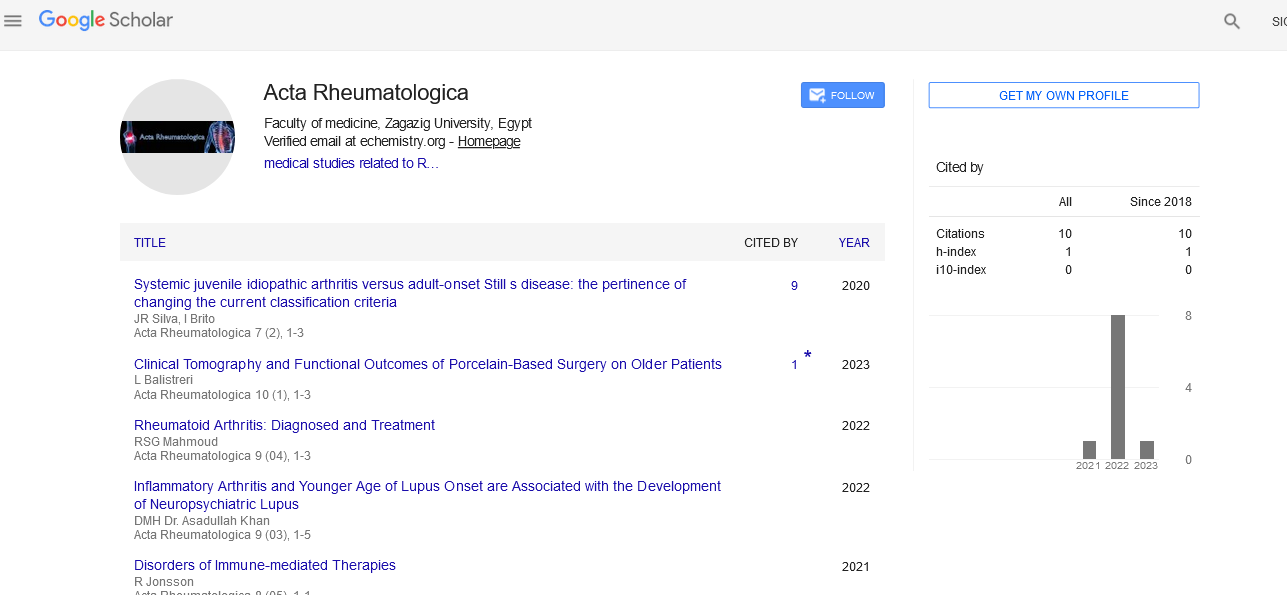Perspective - (2024) Volume 11, Issue 6
Current Advances in Biologic Therapies for Ankylosing Spondylitis
Niall Roche*
Department of Medical Sciences, Herbert Wertheim College of Medicine, United States
*Correspondence:
Niall Roche, Department of Medical Sciences, Herbert Wertheim College of Medicine,
United States,
Email:
Received: 12-Nov-2024, Manuscript No. IPAR-24-15241;
Editor assigned: 15-Nov-2024, Pre QC No. IPAR-24-15241 (PQ);
Reviewed: 29-Nov-2024, QC No. IPAR-24-15241;
Revised: 10-Dec-2024, Manuscript No. IPAR-24-15241 (R);
Published:
17-Dec-2024
Introduction
Ankylosing Spondylitis (AS) is a chronic inflammatory disease
primarily affecting the spine and sacroiliac joints, leading to pain
and progressive stiffness. As a member of the spondyloarthritis
family, AS is closely associated with HLA-B27 antigen positivity
and has significant implications for patients' quality of life.
Traditional treatments, including Non-Steroidal Anti-
Inflammatory Drugs (NSAIDs) and physical therapy, often
provide limited relief. However, recent advances in biologic
therapies have revolutionized the management of AS. This
article explores the latest developments in biologic therapies for
ankylosing spondylitis, their mechanisms, clinical effectiveness,
and the future landscape of treatment.
Understanding biologic therapies
Biologic therapies are designed to target specific components
of the immune system that play a role in inflammation. Unlike
conventional medications that broadly suppress the immune
response, biologics focus on particular pathways involved in the
disease process. In the context of AS, biologic therapies primarily
target Tumor Necrosis Factor-alpha (TNF-α) and Interleukin-17
(IL-17), two critical mediators of inflammation.
Description
TNF inhibitors
TNF-α is a cytokine that plays a central role in the inflammatory
processes associated with AS. Blocking its action can lead to
significant improvements in symptoms and function. Several TNF
inhibitors have been approved for the treatment of AS:
Infliximab: An intravenous TNF inhibitor, infliximab has shown
substantial efficacy in reducing disease activity and improving
quality of life in AS patients. Clinical trials have demonstrated
significant improvements in the Bath Ankylosing Spondylitis
Disease Activity Index (BASDAI) scores.
Etanercept: Given as a subcutaneous injection, etanercept has
been effective in managing symptoms and preventing disease
progression. Its safety profile and ease of use make it a popular
choice among patients.
Adalimumab: Another subcutaneous TNF inhibitor,
adalimumab has been shown to improve physical function and
reduce spinal inflammation. Its effectiveness in patients with AS
has been confirmed in multiple studies.
Golimumab: Administered via subcutaneous injection, golimumab
is a newer option that has demonstrated significant improvements in
patient-reported outcomes and physical function.
IL-17 inhibitors
The advent of IL-17 inhibitors marks a significant advancement
in the treatment of AS. IL-17 is a pro-inflammatory cytokine that
has been implicated in the pathogenesis of AS. Targeting this
pathway has proven effective for many patients:
Secukinumab: This monoclonal antibody targets IL-17A and
has been shown to reduce inflammation, improve physical
function, and enhance the overall quality of life in patients with
AS. Clinical trials have reported significant improvements in
BASDAI scores, as well as Magnetic Resonance Imaging (MRI)
findings of spinal inflammation.
Ixekizumab: Another IL-17A inhibitor, ixekizumab, has also
demonstrated efficacy in treating AS. It offers an alternative for
patients who do not respond to or cannot tolerate TNF
inhibitors.
Clinical effectiveness and safety
Efficacy: Clinical trials have consistently shown that both TNF
and IL-17 inhibitors can lead to rapid and sustained
improvements in symptoms and physical function in patients
with AS. The majority of patients report reduced pain, increased
mobility, and improved overall health status. Long-term studies
indicate that early initiation of biologic therapy can significantly
reduce the risk of radiographic progression of the disease,
underscoring the importance of timely intervention.
Safety profile: Biologic therapies generally have a favorable
safety profile, but they are not without risks. The most common
side effects include injection site reactions, increased risk of
infections, and, in rare cases, the development of malignancies.
Regular monitoring and patient education regarding signs of
infection are crucial for minimizing these risks.
Challenges and considerations
While biologic therapies have transformed the management
of AS, several challenges remain:
Access and affordability: Biologics can be expensive, and
access may vary based on healthcare systems and insurance
coverage. Ensuring equitable access to these therapies is
essential for improving outcomes in all patients.
Personalized treatment: The heterogeneity of AS means that
not all patients respond equally to a given biologic. Identifying
biomarkers that predict response could lead to more
personalized treatment approaches.
Long-term effects: While short to medium-term efficacy and
safety data are robust, more long-term studies are needed to
fully understand the implications of prolonged biologic therapy.
Future directions
As research continues, several areas hold promise for the
future of biologic therapies in AS:
New targets: Investigating additional inflammatory pathways
may lead to the development of novel biologics. For example,
targeting IL-23 or other cytokines involved in the inflammatory
cascade is an area of ongoing research.
Combination therapies: Combining biologics with traditional
DMARDs or other immunomodulatory agents may enhance
efficacy and reduce the risk of disease progression.
Patient-centered approaches: Greater emphasis on patientreported
outcomes and quality of life measures will help refine
treatment strategies and ensure they align with patients' values
and preferences.
Global perspectives: Understanding the impact of geographic
and ethnic differences on disease presentation and treatment
response can guide more effective, region-specific approaches
to managing AS.
Conclusion
The landscape of ankylosing spondylitis treatment has
undergone significant transformation with the advent of biologic
therapies. By targeting specific inflammatory pathways, TNF and
IL-17 inhibitors have demonstrated substantial efficacy in
managing symptoms and improving the quality of life for
patients. As research advances, the potential for new treatments
and personalized approaches offers hope for even better
outcomes. Continued focus on accessibility, safety, and longterm
effects will be critical as we strive to enhance the care and
management of individuals living with ankylosing spondylitis.
Through ongoing collaboration between researchers, healthcare
providers, and patients, the future of AS treatment looks
promising, paving the way for a healthier, more active life for
those affected by this challenging condition.
Citation: Roche N (2024) Current Advances in Biologic Therapies for Ankylosing Spondylitis. Acta Rheuma Vol:11 No:6





